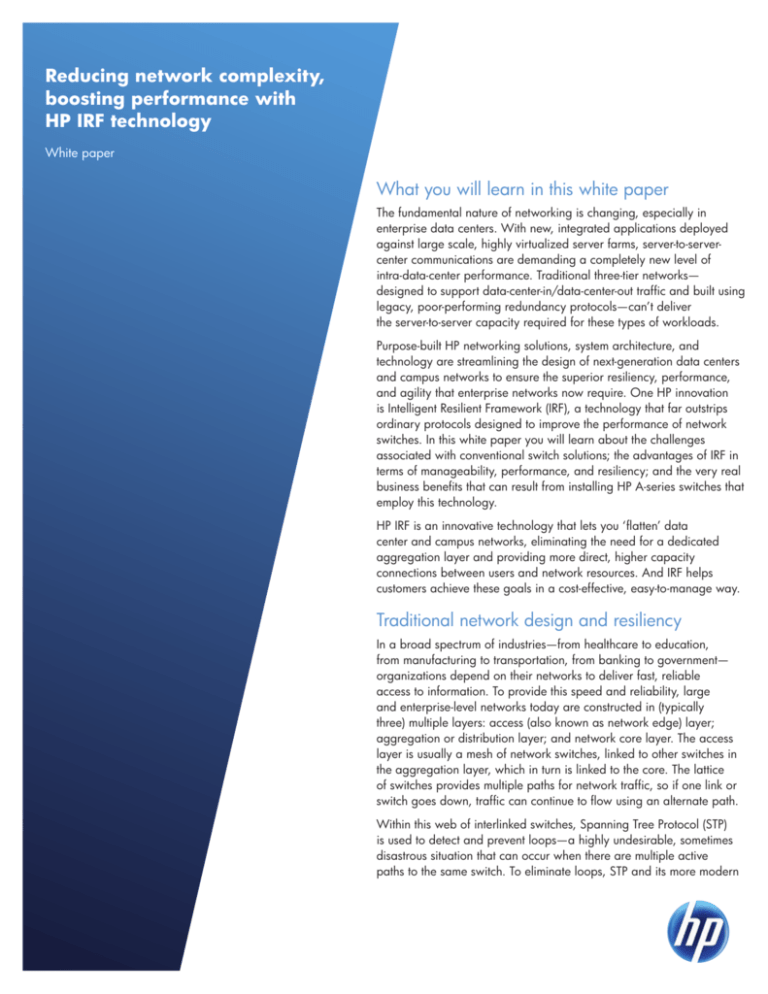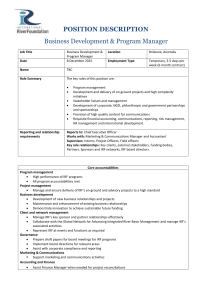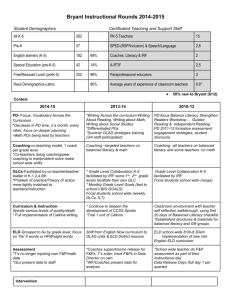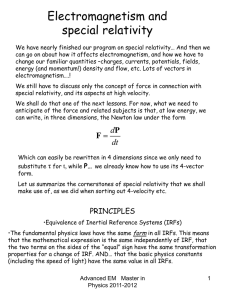What you will learn in this white paper Traditional network design
advertisement

Reducing network complexity, boosting performance with HP IRF technology White paper What you will learn in this white paper The fundamental nature of networking is changing, especially in enterprise data centers. With new, integrated applications deployed against large scale, highly virtualized server farms, server-to-servercenter communications are demanding a completely new level of intra-data-center performance. Traditional three-tier networks— designed to support data-center-in/data-center-out traffic and built using legacy, poor-performing redundancy protocols—can’t deliver the server-to-server capacity required for these types of workloads. Purpose-built HP networking solutions, system architecture, and technology are streamlining the design of next-generation data centers and campus networks to ensure the superior resiliency, performance, and agility that enterprise networks now require. One HP innovation is Intelligent Resilient Framework (IRF), a technology that far outstrips ordinary protocols designed to improve the performance of network switches. In this white paper you will learn about the challenges associated with conventional switch solutions; the advantages of IRF in terms of manageability, performance, and resiliency; and the very real business benefits that can result from installing HP A-series switches that employ this technology. HP IRF is an innovative technology that lets you ‘flatten’ data center and campus networks, eliminating the need for a dedicated aggregation layer and providing more direct, higher capacity connections between users and network resources. And IRF helps customers achieve these goals in a cost-effective, easy-to-manage way. Traditional network design and resiliency In a broad spectrum of industries—from healthcare to education, from manufacturing to transportation, from banking to government— organizations depend on their networks to deliver fast, reliable access to information. To provide this speed and reliability, large and enterprise-level networks today are constructed in (typically three) multiple layers: access (also known as network edge) layer; aggregation or distribution layer; and network core layer. The access layer is usually a mesh of network switches, linked to other switches in the aggregation layer, which in turn is linked to the core. The lattice of switches provides multiple paths for network traffic, so if one link or switch goes down, traffic can continue to flow using an alternate path. Within this web of interlinked switches, Spanning Tree Protocol (STP) is used to detect and prevent loops—a highly undesirable, sometimes disastrous situation that can occur when there are multiple active paths to the same switch. To eliminate loops, STP and its more modern Topology with conventional network switch protocols HP A-series switches with IRF Core/Distribution Core/Distribution Access Access Active/Standby Active/Active Scalable server bandwidth Configuration effort Active link Operational complexity Convergence time Blocked/Standby link IRF platform virtualization User/App experience variants, such as Rapid Spanning Tree Protocol (RSTP) or Multiple Spanning Tree Protocol (MSTP), are designed to allow only one active path from one switch to another, regardless of how many actual connections might exist in the network. If the active path fails, the protocol automatically selects a backup connection and makes that the active path. What Spanning Tree Protocol is—and is not STP is widely used, and is fairly effective at making a network resilient—that is, dealing with a sudden failure of a link between switches. In a network that is operating normally, when a link or switch goes down, STP automatically chooses a backup path, and the network reconverges. After a short period, the network is operating normally again. But for modern, high-speed, mission-critical networks, this approach may not be the best solution. Here is why: Slow network convergence: One problem is that the reconvergence time for STP can be several seconds—a lifetime by modern computing standards. When a garden-variety laptop computer can execute millions of instructions in the blink of an eye, a multisecond network hiccup will have end users cursing the spinning hourglass on their monitors. And a financial transaction that executes in milliseconds cannot wait several seconds for an outdated network protocol to do its job. 2 Management complexity: Even though MSTP and RSTP converge more quickly than the original STP, all of these protocols can be devilishly difficult to configure properly, especially in a large network. You must manage the switches individually, and need to set up spanning-tree instances on each switch in turn, making sure that the parameters for one switch match those of its neighbor. What’s more, troubleshooting spanning-tree-related issues is no easy task, usually requiring a great deal of time to locate the root cause of the failure. Poor performance: Because it blocks all parallel paths except the one it has selected as active, even when the network is operating normally STP actually reduces the effective bandwidth. In fact, half (or more) of the available system bandwidth can be squandered in a backup role, off-limits to data traffic—not a very good use of the network equipment investment. Too many tradeoffs: Even the choice of which protocol to use is difficult. For example, consider the decision of how to handle traffic forwarding over redundant links: should you implement MSTP, which is highly efficient but complex, or should you use STP or RSTP, which are less efficient but easier to configure? HP IRF: a better way Fortunately, HP networking offers a better way. We call it the Intelligent Resilient Framework, or IRF for short. It’s an innovative technology that can actually give you a network that is fully resilient, yet is also simpler to set up and manage, faster to converge, and easier to scale. Let’s have a look. HP IRF platform support IRF runs on the HP A-series of high-end switches. Developed for customers with large or complex deployments who seek the most advanced, fullfeatured networking capabilities, the HP A12500, A9500, A7500, A58XX, and A55XX all come with HP IRF technology built-in at no additional cost. With features like IRF, a common operating system (Comware), and single-pane-ofglass management via HP Intelligent Management Center (IMC), HP networking solutions can help customers simplify the design and operations of their networks. How it works IRF technology extends network control over multiple active switches. Management of a group of IRFenabled switches is consolidated around a single management IP address, which vastly simplifies network configuration and operations. You can combine as many as nine HP A-series switches to create an ultra-resilient virtual switching fabric comprising hundreds or even thousands of 1-GbE or 10-GbE switch ports. One IRF member operates as the primary system switch, maintaining the control plane and updating forwarding and routing tables for the other devices. If the primary switch fails, IRF instantly selects a new primary, preventing service interruption and helping to deliver network, application, and business continuity for business-critical applications. Within the IRF domain, network control protocols operate as a cohesive whole to streamline processing, improve performance, and simplify network operation. So routing protocols calculate routes based on the single logical domain rather than the multiple switches it represents. Moreover, edge or aggregation switches that are dual homed to IRF-enabled core or data center switches “see” the associated switches as a single entity, eliminating the need for slow convergence technologies such as STP. And operators have fewer layers to worry about, as well as fewer devices, interfaces, links, and protocols to configure and manage. Where IRF offers advantages Employing IRF offers a number of benefits over conventional networking. You will find advantages in three major areas: simplicity, performance, and resiliency. Advantages in simplicity •Design and operational simplification: With IRF, no longer must you laboriously connect to, configure, and manage switches individually. You perform a configuration on the primary switch, and that configuration is distributed to all associated switches automatically, considerably simplifying network setup, operation, and maintenance. And while all HP A-series switches can be provisioned via the command line, adding HP Intelligent Management Center (IMC) makes management even easier. IMC lets you see and control the entire network from a single console by consolidating management of multiple, discrete devices into a single, easy-to-manage, virtual switch that operates at every layer of the network. •Flatter topology: IRF makes possible a simplified, higher performing, more resilient, and flatter network design. In fact thanks to IRF and HP A-series switches, enterprise networks can be designed with fewer devices and fewer networking layers—a big improvement over the low performance, high cost, and crippling latency of conventional multi-tier legacy solutions, which often rely on a variety of different operating systems and complex resiliency protocols. Advantages in performance •Higher efficiency: IRF’s loop-free, non-blocking architecture keeps all links active, enabling highly efficient, high-bandwidth connectivity throughout the switching plane. Simply stated, you get all the bandwidth you are paying for. •Scalable performance: IRF and Link Aggregation Control Protocol (LACP) used together can further boost performance by bundling several parallel links between switches and servers, allowing scalable “on-demand” performance and capacity to support critical business applications. •Faster failover: Should a network failure occur, IRF can deliver rapid recovery and network reconvergence in under 50 milliseconds—much faster than the several seconds required for STP. Advantages in resiliency •Distributed high availability and resiliency: For high availability, the IRF fabric can be configured for full N+1 redundancy, while mission-critical virtualization capabilities such as live migration and application mobility are available across the IRF domain and extend across the Layer 2 WAN infrastructure. •Geographic resiliency: Within an IRF domain, the geographic location of switches does not matter. Switches can be extended horizontally, and they continue to function as a single logical unit whether they are installed locally, distributed regionally, or even situated at distant sites. Moreover, employing IRF can enhance disaster recovery by linking installations up to 70 kilometers apart and giving them the same fast failover as if they were sitting side by side within the data center. Such location independence is extremely important to support the global on-demand application access and dynamic traffic flows of today’s technology-oriented businesses. •In-Service-Software-Upgrade: IRF delivers a network-based In-Service-Software-Upgrade (ISSU) capability that allows an individual IRF-enabled switch to be taken offline for servicing or software upgrades without affecting traffic going to other switches in the IRF domain. 3 Table 1. Summing up the advantages of IRF compared to STP-based designs and other solutions HP IRF-based designs STP-based designs Competitive solutions Yes No Varies by protocol Sub 50 milliseconds Often measured in seconds Design simplification—common across data center/campus core/edge Yes No No Virtualizes up to 9 switches Switch by switch configuration Different protocols used at each layer and device type Support for Layer 2/3, MPLS, IPv6 protocols Yes L2 only Varies by protocol Performance Very high Low High Rapid failover Common across layers/devices Design/Device specific Geographic resiliency Overall administration effort and cost Yes No Unclear Supported across 70 km L2 only, limited to site Varies by protocol Low High High No extra cost No extra cost Often requires additional license and hardware What you gain Investment protection Employing HP A-series switches with IRF offers a wide range of business benefits that are visible not only to network administrators, but to a company’s accountants and C-level executives as well. Using standards-based protocols such as LACP, HP IRF switches can interoperate with the existing switches deployed in your network, providing investment protection and seamless migration. Greater availability for business-critical Summing up applications HP Intelligent Resilient Framework is particularly well suited to providing the high availability and consistent service levels required in mission-critical deployments. Its simpler architecture, faster failover, and greater resilience add up to marked improvements in availability over architectures based on Spanning Tree and other conventional network protocols. Increased performance and better network ROI The HP approach to networking is focused on driving innovation that reduces complexity, delivers breakthrough economic benefits, and empowers customers to deploy the network as a business enabler. This approach is fully developed in HP A-series switches with IRF, a technology that can deliver excellent resiliency along with less complexity and better performance throughout your switched network. Because it allows redundant links to be active without creating loops, IRF technology can use the full Want to learn more? capabilities and bandwidth of each switch, ensuring greater overall efficiency and maximizing return on the Visit the HP website to learn more about investment in networking infrastructure. HP networking and how to contact us. See: Lower operating costs www.hp.com/go/networking By allowing a flatter, fully resilient topology, IRF can actually reduce the number of components in the network; this has the advantage of lowering costs for power and cooling, greatly simplifying network planning and operation, and freeing staff for more productive tasks. The result is reduced overall operating and administrative expenses. Share with colleagues Get connected www.hp.com/go/getconnected Get the insider view on tech trends, alerts, and HP solutions for better business outcomes © Copyright 2010 Hewlett-Packard Development Company, L.P. The information contained herein is subject to change without notice. The only warranties for HP products and services are set forth in the express warranty statements accompanying such products and services. Nothing herein should be construed as constituting an additional warranty. HP shall not be liable for technical or editorial errors or omissions contained herein. 4AA2-9402ENW, Created September 2010








